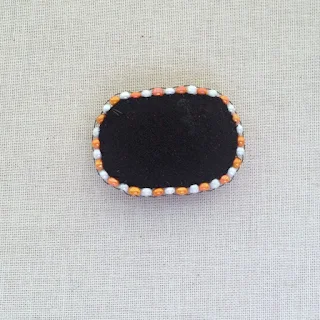Sew, what's new with you?
Bead embroidery is not new to me. I used to do it quite a bit when I was in college - more to embellish clothing than to make jewelry. It works wonders to cover stains. (I kid you not).
But, of course, everything is different when you decide you really want to learn how to do it the right way. That means identifying the materials, tools, techniques, etc. Apparently, you can't just stitch your beads to an old t-shirt to make bead embroidery jewelry.
So, that's where I'm at right now - starting over and trying to do things
Yes, that's the truth. I just have trouble accepting point blank what I read and I'll just have to find out myself. And I also hate it when there are supplies I need that I can't buy in the store. Here's where I'm at with bead embroidery materials so far...
Beads!
If you've never done bead embroidery before, one thing you may be thrilled to know is that it doesn't require the perfectly uniform (i.e. expensive) beads that work best for loom weaving and many other off loom techniques like peyote.
Just about any old beads will work. And unlike a lot of other techniques, the uneven beads are actually a good thing - since it can help you fill up spaces to avoid the backing from showing.
Foundation
Unlike off loom bead weaving where the beads are connected to other beads, bead embroidery uses stitches to attach beads to a backing - also known as beading foundation.
There are many options for foundations - but most jewelry projects recommend a product called Lacy's Stiff Stuff . The one down side of Lacy's is that it is only available in white. The color issue - plus the fact that my local craft stores don't carry Lacy's - made me look for another option.
Here's a look at one of my in-progress pieces on stiffened felt. I wish I had used black for this - but live and learn. You'll see why when I post the finished project - it could've been just a little better.
Some other options are ultra-suede, thin suede, leather - basically a stiff, not stretchy, non-fuzzy fabric that won't break your needle. Interfacing can also be used to stiffen fabrics.
Regular felt, however, is not recommended. The fibers are looser and you end up with fuzz in your beadwork. This article has more information about bead embroidery foundations (but no mention of stiffened felt).
Thread & Needles
I've been using 6 lb Fireline in smoke or crystal to get started - but I also have Nymo size D in light tan color on the large spool (not the bobbins) That works great too, so it just depends what color I need as to which one I use. I don't condition or wax the Nymo for bead embroidery since the wax will get stuck on the cloth.
I'm using a size 10 or 12 needle - which is what I normally use for bead weaving. Lots of people are particular about the brand of needle they use - i.e. Tulip
Backing
I feel like I shouldn't have called the fabric foundation for the beadwork backing because there's also a layer of fabric that goes on the back of the finished jewelry called - you guessed it - backing!
But this isn't stitch backing - it's make your pendant or finished piece pretty backing.
I have ultra-suede cloth that I've used - but it's not the thick ultra-suede and I think that is what I really need. Until I get it, I'll use the suede cloth because it's main purpose is to protect the stitches and makes the back look nice - but a slightly thicker backing will work better.
I use a fabric glue to join the embroidery to the backing and then trim the backing to size before stitching the edge with brick stitch.
Stitches
To get started with the stitches, I have watched a few short videos on bead embroidery from Beadaholique. They have been very helpful. There's also this article on bead embroidery stitches at beadwork.about.com.
For now, I've only completed a few projects, but one of the things I like most about bead embroidery is that it is easy to make curved shapes - as opposed to using brick stitch or peyote where a circle always has jagged edges.



For backing I have found adhesive backed felt works famously. Best part is not having to worry about glue getting too far out. However if I make a piece to sell I would most likely use ultra suede.
ReplyDelete